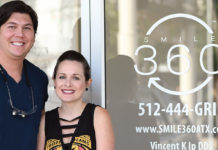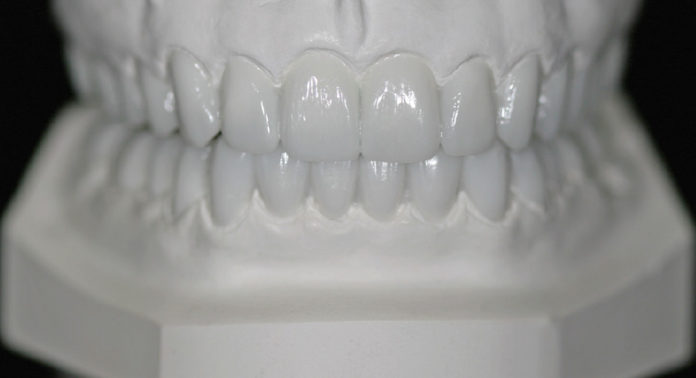
According to some estimates, as many as 70 percent of practicing dentists have never done a full arch reconstruction (FAR) in one seating. Since it can be a life-changing procedure for the patient and a good business proposition for the dental practice, the question is, why?
After working for several years with dentists on advanced cases, I think that some dentists never attempt a FAR primarily because of fear. New dentists (and even some seasoned ones) worry that they might not have the skills that are needed to deliver the best possible outcome. Sometimes, dentists are overwhelmed by the learning curve of the task, but they fail to fully understand that there are ways of making such a complex undertaking much more simple.
Other dentists are concerned about the sheer number of teeth they would have to restore with such a procedure. And still other doctors are reluctant to try a FAR case because they worry there will be a lot of maintenance issues down the road. However, maintenance issues sometimes happen because a doctor didn’t adequately address a problem, such as the occlusion, at the outset.
You’re Not Alone
The most important message I can convey is that help is available for all dentists. New and improved dental tools (such as electric handpieces and lasers), specific guides (including the ones described in this article), and assistance from lab technicians and other experts can supplement a dentist’s knowledge while he or she is learning new skills.
Expert technicians are trained to identify and resolve a case’s weak spots, and they can help doctors use the latest guides for top-level outcomes. As a technician, part of my job is to advise doctors about how to start and complete a full mouth reconstruction case.
At Arrowhead Dental Laboratory in Salt Lake City, UT, we’ve developed a system of products that gives dentists a recipe for success. This “recipe” is like a checklist of steps that, if followed correctly, will help dentists confidently predict and achieve the desired outcomes. Yes, dentists need to allow some room for the minor variations that they will encounter with each patient, but it’s basically the same process for everyone. Therefore, this system of guides can be used on all FAR patients to simplify and elevate the process.
Tools of the Trade
Before starting a full mouth reconstruction on a patient, all dentists should invest in the proper tools and learn how to use them correctly. Some dentists are somewhat slow at prepping. All dentists should examine how long it takes to prep a tooth, and then ask themselves why it takes that amount of time.
Slower than average times may be due to the fact that a dentist is using a less-efficient instrument, like an air-driven handpiece. Many dentists are comfortable with air-driven handpieces because that’s what they are taught to use in dental schools.
Electric handpieces have so much power, however, that they reduce the time needed to prep. Electric handpieces are initially more expensive than air-driven handpieces, but because they save chair time during prep, they actually save the doctor time—and therefore money. In the Beyond the Basics course with the Dr. Dick Barnes Group (DDBG), we teach doctors efficient ways to prep with precision and various techniques for achieving better speed and accuracy.
Other important tools that help doctors with comprehensive dentistry include a dental laser for soft tissue contouring (see Dr. Jim Downs’s article, “Framing the Picture,” in the Summer 2018 issue of Aesthetic Dentistry) and a T-Scan® by Tekscan®—a digital analysis system to evaluate occlusion. The T-Scan® can be used for pre-op evaluation of occlusion and of bite force and timing. It is a must for dialing in and protecting the patient’s restorations.
A well-equipped armamentarium helps in the elevation of every full mouth reconstruction case. Such tools give dentists more precision, offer more efficient chair time, and lead to superior results.
The System
As mentioned, Arrowhead Dental Lab has created a system of guides to help with FAR cases. These guides function great independently, but when used together and in the proper sequence, they lead to the best possible results. They were developed specifically to help dentists dial in their full arch and full mouth reconstruction cases. Two of the guides (the tissue-contouring guide and the V-Bite) are brand new for 2020! Here’s the system and sequence that we recommend:
The White Wax-Up
 A White Wax-Up is a stunning 3D model that not only shows the optimal clinical diagnostics of a reconstruction case, but also shows a beautiful simulation of the final result. With any comprehensive case, start by asking the patient such health questions as, “How well do you sleep? Do you snore? Do you have headaches, neck aches, or back aches?” By understanding a patient’s symptoms, dentists can learn if occlusal or sleep issues are contributing to the problem. With comprehensive dentistry, dentists can improve their patients’ quality of life and give them an aesthetic smile at the same time.
A White Wax-Up is a stunning 3D model that not only shows the optimal clinical diagnostics of a reconstruction case, but also shows a beautiful simulation of the final result. With any comprehensive case, start by asking the patient such health questions as, “How well do you sleep? Do you snore? Do you have headaches, neck aches, or back aches?” By understanding a patient’s symptoms, dentists can learn if occlusal or sleep issues are contributing to the problem. With comprehensive dentistry, dentists can improve their patients’ quality of life and give them an aesthetic smile at the same time.
Showing each comprehensive patient a White Wax-Up is important. With this tool, the case for better health can be made and it can be tied to cosmetic improvement. A White Wax-Up also allows everyone—doctor, patient, and lab—to visualize the case and test it from different perspectives. It’s the equivalent of a blueprint for the new smile.
The Tissue-Contouring Guide
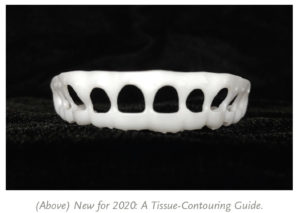 A key part of the full mouth reconstruction (and one that is sometimes overlooked) is tissue contouring. Also called gingival contouring, it is vital to the aesthetic outcome of every comprehensive procedure. This new product shows dentists how soft-tissue contouring can visibly accentuate the results of the procedure.
A key part of the full mouth reconstruction (and one that is sometimes overlooked) is tissue contouring. Also called gingival contouring, it is vital to the aesthetic outcome of every comprehensive procedure. This new product shows dentists how soft-tissue contouring can visibly accentuate the results of the procedure.
Without a reference guide, dentists often verify symmetry by stretching a piece of floss from canine to canine to check that the gingiva is even, then blanching tissue, and then getting a grease pencil to outline where to go with the laser. With this method, dentists may end up skipping the premolars because of time constraints—the entire process takes about half an hour.
With a tissue-contouring guide, tissue contouring can be done in as little as five to ten minutes. The dentist follows the exact contouring on the White Wax-Up itself. (Arrowhead uses a scan of the wax-up to build the tissue-contouring guide.)
The tissue-contouring guide is worth every penny because the gingiva is visible to patients and doctors alike. If dentists don’t sculpt the tissue correctly, it throws off the symmetry and the contouring of the crowns.
Every patient wants amazing results, and tissue contouring is an essential element to the overall outcome. Dr. Downs calls the gingiva the “frame around the picture.” Without attention to this part of the case, the result can look incomplete.
I rarely see a wax-up of a case that couldn’t improve with some gingival contouring. Even if the patient’s smile doesn’t really show the gingiva, dentists still have to pay attention to it, because the patient will notice it. Everything is interdependent.
The Reduction Guide
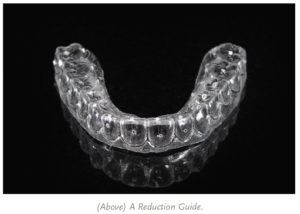 The reduction guide does exactly what its name suggests—it shows dentists how much of a tooth to reduce, indicating where there should be more reduction on some teeth and less on others. It is a clear stent that is placed over prepped teeth to verify that sufficient reduction has been achieved.
The reduction guide does exactly what its name suggests—it shows dentists how much of a tooth to reduce, indicating where there should be more reduction on some teeth and less on others. It is a clear stent that is placed over prepped teeth to verify that sufficient reduction has been achieved.
The design of the stent includes perforated holes to probe tooth surface thickness and confirm that reduction has been achieved according to industry standards. The White Wax-Up includes cast models of prepped teeth that act as an aid to the clear reduction guide in determining appropriate angulation. As such, it can help clarify possible problems in the case.
The reduction guide can help increase a dentist’s confidence with prepping, and it also ensures that reduction spotting at the time of seating won’t be necessary for the best aesthetics. The reduction guide allows dentists to prep effectively and accurately on the first attempt. It takes the guesswork out of prepping, providing a jig that brings accuracy and consistency for the best results.
The V-Bite or the Sil-Tech® Bite
 During the past several months, Arrowhead has been developing a new tool called a V-Bite, which is launching at the Chicago Dental Society Midwinter Meeting in February 2020. The V-Bite creates a stable platform for patients and is an alternative bite tool. It’s designed as a tripod system—with platforms for the second molars or most distal tooth, and a platform for tooth numbers 8, 9, 24, and 25. When the patient closes, the V-Bite holds the vertical and the anterior-posterior positions. Dentists can see that the V-Bite is in place, measure and verify the Shimbashi or VDO (vertical dimension of occlusion), and reline over a bar with bite registration.
During the past several months, Arrowhead has been developing a new tool called a V-Bite, which is launching at the Chicago Dental Society Midwinter Meeting in February 2020. The V-Bite creates a stable platform for patients and is an alternative bite tool. It’s designed as a tripod system—with platforms for the second molars or most distal tooth, and a platform for tooth numbers 8, 9, 24, and 25. When the patient closes, the V-Bite holds the vertical and the anterior-posterior positions. Dentists can see that the V-Bite is in place, measure and verify the Shimbashi or VDO (vertical dimension of occlusion), and reline over a bar with bite registration.
Because of its precision, the V-Bite is verifiable every time. Whether or not the patient’s muscle memory is intact (sometimes it isn’t—for example, when the patient is numb), or whether or not a patient’s jaw deviates when closing, the dentist will have a hyper-accurate baseline against which he or she can build everything else.
Why is this so important? If the baseline is off even by a millimeter at the beginning of the restorative process, the dentist will get a translational error in each subsequent step, and he or she will start “chasing the bite” as the case progresses. It’s usually possible to eventually get it perfect again, but it’s a significant timesaver to have it correct from the outset. The V-Bite complements and verifies placement.
If a patient has minimal vertical increase, or an unusual occlusion, it may be advisable to use the Sil-Tech® bite instead of the V-Bite. The Sil-Tech® bite is guide that can be used on every case with a vertical increase. It adapts to all types of occlusal situations. It is the standard for capturing and transferring an accurate record for a full arch or full mouth verticalizing restorative case.
This bite is made to the same vertical and anterior-posterior position that is established through splint therapy. Dentists follow the tripod technique that Dr. Jim Downs teaches at the FAR, Everyday Occlusion and Clinical Hands-On continuing education (CE) courses with the DDBG. The Sil-Tech® bite is included with the White Wax-Up in every verticalizing case.
The Sil-Tech® Matrix
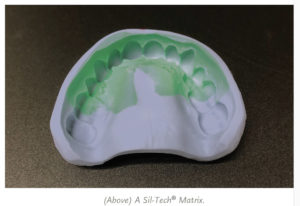 Arrowhead’s White Wax-Up includes a Sil-Tech® matrix so that doctors can make chairside temporaries. The purpose of the Sil-Tech® matrix is to essentially replicate the White Wax-Up in the patient’s mouth as a trial of the final restorations, and to accelerate the process of fabricating and placing the temporaries.
Arrowhead’s White Wax-Up includes a Sil-Tech® matrix so that doctors can make chairside temporaries. The purpose of the Sil-Tech® matrix is to essentially replicate the White Wax-Up in the patient’s mouth as a trial of the final restorations, and to accelerate the process of fabricating and placing the temporaries.
It’s designed with a bead around the gumline to minimize the flash from the temporary material, and also to shorten the clean-up process. The Sil-Tech® matrix allows dentists to quickly fabricate a full arch of temps and do a test drive of them (see photo, above right).
Recipe for Success
Part of my job is to foresee any issues and guide doctors through the process, so they won’t have problems as the case progresses. I help ensure that each case goes smoothly. I encourage my team members to point out any potential red flags with each case, because the technicians’ knowledge is a key component of the Arrowhead system.
When doctors use all that Arrowhead provides, including skilled technical support, the outcome is excellent. As doctors advance their skills, I encourage them to stay in touch with their mentors and Arrowhead’s team members.
If you want to do a full arch restoration, I say, do it! Start with the right tools—literally and figuratively. Take the DDBG courses or other CE courses to improve your skills, and use the tools and guides designed to make the process more predictable.
Don’t hesitate to lean on technical support, because that’s what we’re here for. We will help you develop a detailed, integrated plan for each of your cases. At Arrowhead, it’s part of our system of guides, which was designed so that full mouth rehabilitation could be predictable and replicable, while offering the highest aesthetic outcomes possible.



